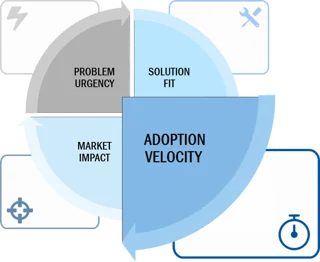Our Concept Testing blog series continues today with a look at the third of the four dimensions of concept testing – Adoption Velocity.

In previous posts, we looked at both Problem Urgency (determining both the existence of a perceived problem and the degree of urgency to which solution is required) and Solution Fit (whether your solution provides a complete, satisfactory solution to the perceived problem).
Dimension 3 – Adoption Velocity – addresses two additional concerns:
- How well does the price match the concept value proposition?
- How strong is the purchase intent?
Reminder, we are working with the following as a definition of concept testing – A concept test is a presentation of an idea, new technology, approach, or product, in varying states of completeness, that is designed to receive a response from a specific audience to determine its fitness for a market and its purpose, relative to its cost.
It is critical to evaluate the concept’s value relative to cost. In other words, the comparison between the value received from the concept and its ‘cost’ is a real value that needs be determined in the test.
Value
The value of the concept: What do I get out of it? What benefits do I reap? In what way is my job made easier, my business more profitable, my home life smoother, my commute less frustrating? A simple way to look at this: is it a vitamin (helps me do things more quickly) or a painkiller (helps me do something less painfully)? The first two dimensions are excellent gauges of Value.
Cost
And the flip side of the coin, cost: price, initial outlay, monthly investment, financing, and even factors such as licensing and warranty must be taken into account.
Value Relative to Cost
The relationship between value and cost is the key. Low value plus high cost equals a product no one buys. High value plus low cost equals lost revenue, or even a perception shift as to the quality or worth of the product. An integral component of concept testing, then, is to determine the optimal price for the product as a factor of the value.
The determination of Problem Urgency and Solution Fit establish concept value in fine detail. Measuring the strength of the value proposition relative to price enables a determination of price elasticity, an indicator of which price best matches the perceived value of the product. While certainly a challenging question to answer effectively in marketing research, scientific price modeling is, in our opinion, imperative to ascertain prior to the launch of any new product.
Purchase Intent
The second component of Adoption Velocity testing is purchase intent. Not the need and desire for your product, or willingness to purchase at a certain price, but the actual intention to do so. A failure to examine this component can lead to an inflated sales expectation.
The primary benefit of testing purchase intent strength is to get an early indicator of sales potential. Positive results will provide a good read on adoption and market segmentation. Negative results may point towards weaknesses or lack of general appeal in the product itself. Ideally, purchase intent is tested in both quantitative and qualitative environments. In the simplest terms, purchase intent answers the questions… Will they buy? Why or why not?
In more complex terms, a host of other factors must be considered when looking at purchase intent:
- When will they buy?
- Is current inventory a concern?
- How long are my purchasing cycles?
- What signals the buyer’s need for a new purchase?
- Who makes the final decision for a purchase?
- How much influence does the concept tester have?
Wrapping Up
Testing price value and purchase intent are both essential and challenging, and are an excellent argument for engaging a solid marketing research team.
Marketing research is the best approach to concept testing. Working with an experienced team will generate unbiased results that are accurate, targeted, and actionable.
Be sure to tune in for the fourth dimension of concept testing, Market Impact, and the rest of the Actionable Research Concept Testing blog series. And keep an eye out for our upcoming white paper on the subject, entitled “Actionable, Comprehensive Concept Testing,” available for download soon.



